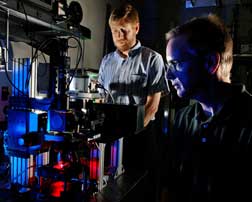NEWS RELEASES
FOR IMMEDIATE RELEASE
August 9, 2006
Sandia National Laboratories and Monsanto Company announce cooperative research agreement
 Sandia National Laboratories researchers Michael Sinclair (foreground)
and David Haaland prepare a hyperspectral confocal microscope for
measurement of a biological specimen. The new microscope, shown on the
left, was designed and fabricated at Sandia and is expected to be used
by Monsanto to enhance the company's current crop analytical
technologies. (Photo
by Randy Montoya)
Sandia National Laboratories researchers Michael Sinclair (foreground)
and David Haaland prepare a hyperspectral confocal microscope for
measurement of a biological specimen. The new microscope, shown on the
left, was designed and fabricated at Sandia and is expected to be used
by Monsanto to enhance the company's current crop analytical
technologies. (Photo
by Randy Montoya)Download 300dpi JPEG image, “hyperspectral-imaging.jpg,” 672K (Media are welcome to download/publish this image with related news stories.)
LIVERMORE, Calif. and ST. LOUIS — Sandia National Laboratories and Monsanto Company today announced a three-year research collaboration that is expected to play a role in both organizations’ interests in biology and bioenergy.
The arrangement is aimed at aligning Sandia’s capabilities in bioanalytical imaging and analysis with Monsanto’s research in developing new seed-based products for farmers, including corn products that may be able to produce more ethanol per bushel. Financial terms of the agreement were not disclosed.
“A strategic relationship with Monsanto makes sense on many levels and will bolster our collective long-term objectives in bioenergy and biofuels,” said Terry Michalske, director of Sandia’s Biological and Energy Sciences Center.
Sandia is a National Nuclear Security Administration laboratory.
The research, which falls under a five-year “umbrella” cooperative research and development agreement (CRADA), will initially focus on hyperspectral fluorescence imaging and spectral analysis. Researchers from the two organizations will apply Sandia’s hyperspectral imaging and multivariate image analysis technology to aid in the study of plant tissue samples of interest to Monsanto.
The research is expected to enhance current crop analytical technologies, offering an additional technological resource to support Monsanto’s robust product discovery engine and development pipeline. Monsanto’s crop analytics research program has recently played a role in discovering new seed-based products for farmers, including corn hybrids that offer more ethanol-output per bushel and soybean varieties that produce more nutritious oils for consumers.
“Seeking out new and innovative scientific tools is an important part of how we bring forward new technologies for the farmer,” said Pradip Das, director of Crop Analytics for Monsanto. “This collaboration provides Monsanto with a new opportunity to further augment our existing crop analytics program, offering our researchers another way to better understand genomic profiles for seed and trait development.”
Sandia researchers in New Mexico will investigate, develop, and further advance the lab’s hyperspectral imaging and multivariate data analysis methods and capabilities for agricultural product discovery and development applications. Hyperspectral imaging is an advanced scanning technology that provides significantly more information on a subject of interest than other scanning technologies commercially available today, by detecting microscopic images using a continuous spectrum of light.
Michalske noted that researchers at Sandia’s Combustion Research Facility (CRF) in California could eventually benefit from the CRADA by gaining experience with agricultural samples that have bioenergy/biofuel applications and uses.
Ancillary research focusing on the photosynthetic properties of various plants and microbes, for instance, will add to the laboratory’s growing expertise in understanding the conversion of sunlight to sugars, relevant not only to the production of new fuels from biomass but also essential to the global carbon cycle and carbon sequestration.
Recent biotechnology endeavors at Sandia have focused on developing and applying biotechnologies to identify early signs of infectious diseases through protein interactions and biomarkers at the single cell and whole organism scale. Sandia is also planning a key role in a multi-lab/university effort to bring a Department of Energy-funded bioresearch facility to the San Francisco Bay Area. The DOE’s Office of Science reissued a solicitation last week for two such facilities, with a focus on cost-effective, biologically based renewable energy sources to reduce U.S. dependence on fossil fuels.
Monsanto Company is a leading global provider of technology-based solutions and agricultural products that improve farm productivity and food quality. For more information on Monsanto and the company’s products, see www.monsanto.com.
Sandia is a multiprogram laboratory operated by Sandia Corporation, a Lockheed Martin company, for the U.S. Department of Energy’s National Nuclear Security Administration. Sandia has major R&D responsibilities in national security, energy and environmental technologies, and economic competitiveness.
Sandia news media contact: Mike Janes, mejanes@sandia.gov, (925) 294-2447
Monsanto Company news media contact: Lee Quarles, lee.quarles@monsanto.com, (314) 694-2330